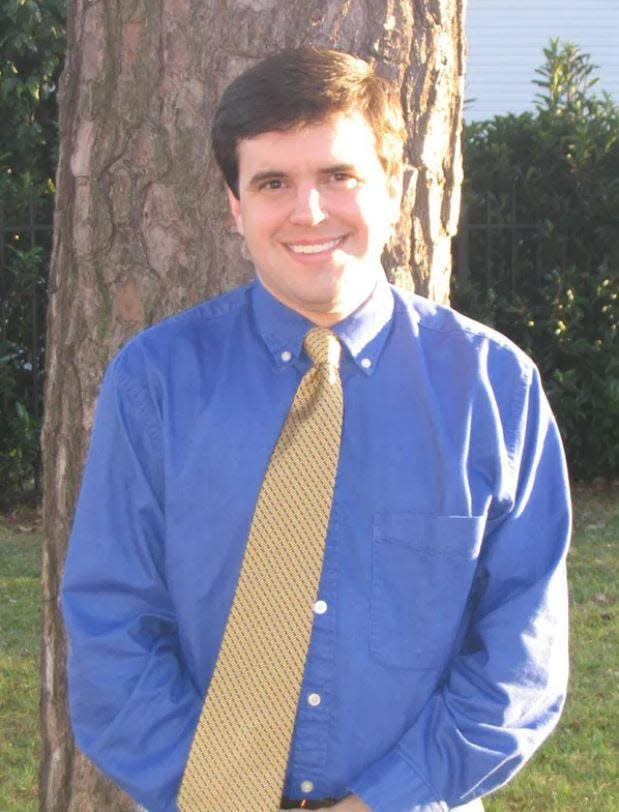Bridges history column: Texan Sandra Day O’Connor, part 1
- Oops!Something went wrong.Please try again later.
The Supreme Court of the United States is the highest court in the land and the last word on the authority and meaning of the Constitution short of an amendment. The court has handed down many decisions affecting American life and law. The justices who preside over the court sometimes become household names. Texas has produced a number of noted legal minds to serve on the court, including the nation’s first woman justice, Sandra Day O’Connor.
Sandra Day was born in March 1930 in El Paso, the oldest of three children to ranchers Harry and Ada Day. The family also acquired a huge ranch in Arizona, so the future justice spent a lot of her childhood going back and forth between Arizona and Texas. Years later, she and her brother would compile some of their memorable childhood exploits in the book Lazy B: Growing Up on a Cattle Ranch in the American Southwest.

At school, she excelled. Fellow students remembered her as extremely intelligent and very kind. She graduated from El Paso’s Austin High School in 1946 at the age of 16. She quickly enrolled at Stanford University in California. She graduated with high honors in 1950, earning a degree in economics. Wanting to go further, she applied for and was accepted into Stanford Law School.
The law would change her life. At Stanford, she met and briefly dated future Chief Justice William Rehnquist. Rehnquist even went so far as to propose to her in 1951, but she declined. She soon began dating fellow student John Jay O’Connor of California while the two worked on the school’s law journal. After she graduated in 1952, the two married.
In spite of graduating from one of the nation’s most prestigious law schools, she found it difficult to find a job as an attorney because she was a woman. No private firm would hire her, and even state and local prosecutors were reluctant to hire her. Eventually, she talked her way into a position with the San Mateo County prosecuting attorney’s office as a deputy county attorney. She would receive no salary and would not even have her own office. Nevertheless, she worked hard to show her skill. Eventually, she was given a modest salary and given more responsibilities.
Her husband was drafted into the army in 1954. O’Connor went to Germany with him and worked as a civilian attorney with the army’s Quartermaster Corps until her husband’s honorable discharge in 1956. The two then moved to the Phoenix area where her husband had received a position with a noted local law firm. They would soon have the first of their three sons. For the time being, she stayed home with their growing family.
While she was raising her young sons, she began getting active in Arizona politics. Arizona’s Sen. Barry Goldwater was the Republican nominee for president in 1964, and O’Connor volunteered for his campaign. Though Goldwater lost, in 1965, Democratic Gov. Samuel Pearson Goddard appointed her as Arizona’s assistant attorney general. In 1969, Gov. Jack Williams, a Republican, appointed her to an opening in the state senate. She worked well with the senators of both parties, gaining a reputation as a moderate and an able negotiator and legislator. In 1973, she was named Senate Majority Leader, becoming the first woman in the country to head any state legislative chamber.
In 1974, she returned to the law and was appointed as judge for the Maricopa County Superior Court, a prestigious position on the highest court in the state’s largest county. In 1978, she was elected to the Arizona Court of Appeals.
In July 1981, Supreme Court Justice Potter Stewart announced his retirement. President Ronald Reagan narrowed down a list of choices and decided to nominate O’Connor to fill the vacancy. She later reported she was surprised by the nomination and did not know she was a finalist for the position. By September, she was confirmed by the U. S. Senate to become the nation’s first woman justice on the Supreme Court where she would serve for the next 24 years.
Ken Bridges is a writer, historian and native Texan. He holds a doctorate from the University of North Texas. Bridges can be reached by email at drkenbridges@gmail.com.
This article originally appeared on Amarillo Globe-News: Part 1: Sandra Day O’Connor, first female Supreme Court justice
